Common Milkweed - asclepias syriaca
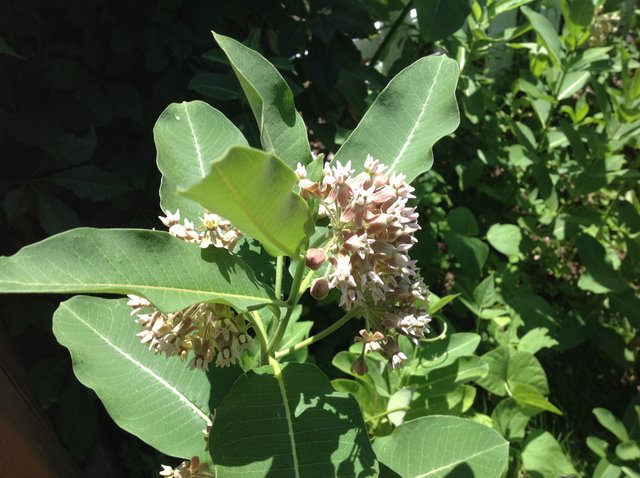
My how times change. Four years ago, I found myself ordering milkweed seeds online. In my youth, that would have been unheard of - it's a weed - but in our more environmentally conscious times I had decided to help save the Monarch butterflies.
My province considers milkweed to be a noxious weed, poisonous to some livestock. Now, animals are not stupid. Given the choice, there are other foods they would eat before poisoning themselves, but in the one documented case, there was a drought and the milkweed were eaten by some sheep. The sheep died and so, not just the common milkweed that killed them, but all milkweed went on the naughty list.
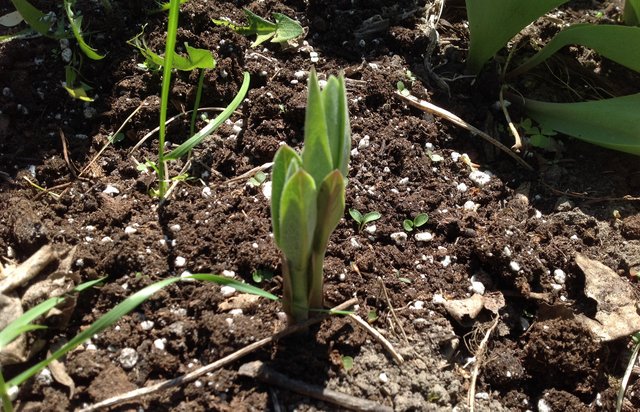
So here I was ordering common milkweed seeds. When the seed arrived, I read the growing instructions which said they required stratification.
What is Stratification?
Seed stratification is the process of breaking the seed's dormancy to promote germination. To be successful, it's necessary to mimic the conditions the seed would require in nature. For milkweed seeds, this meant a cold period. For other seeds, it might be warm and wet, or cool followed by warm - it all depends on what the seed would have in nature.
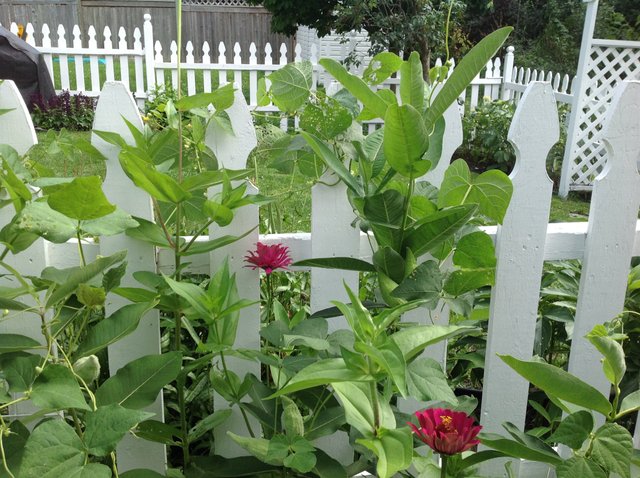
I don't recall the exact temperature except that it was basically my refrigerator temperature for a month. I popped the seeds into a sealed plastic container, thinking cold might dry the seeds, and in they went. Good idea, since more recently I learned milkweed seeds prefer cold and moist, not just cold stratification.
That spring, I planted them and watched them grow and observed their whole lifecycle. They are actually a pretty plant. For three springs, I have watched and waited to see if they would return, getting down on my hands and knees to count them as they came up. The first two years it was every single one I planted... but they didn't seem to thrive.
Surely weeds are easy to grow...
Last year, I added some small flowers and the first Monarch butterfly appeared. This year, the milkweed took off with a vengance, surprising me by sprouting up 2 feet (just over 60 cms) away from the bed in my lawn! Well, their underground rhizomes are working. But then I decided it made sense to expand the bed and grow more flowers for the butterflies. In fact, the milkweeds seemed to prefer crowded conditions (as if they were a weed or something.) It was a success! They had two great years and I saw several Monarch butterflies both years.

The photo, above, was from last year before I added the big zinnias. Milkweeds are actually pretty plants until they get a little ratty looking in the late fall. Adding large plants to hide them is a good plan. Their seed pods are large and must require a lot of energy to produce. I always cut them off as they will reseed pretty easily.
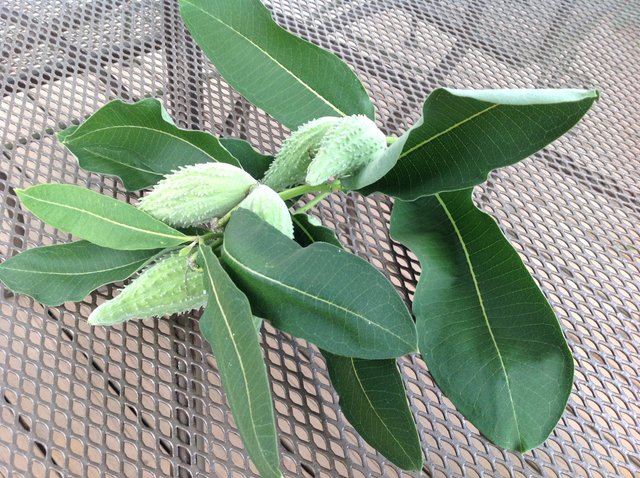
Below are some I left on the plant a little longer. They gradually yellow and when the seeds are mature, will split open on their own. (Those leaves are from my pole beans that climbed them.)
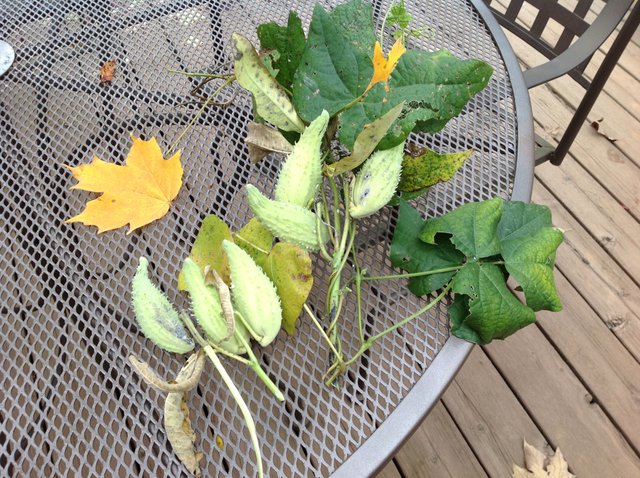
When this happens, you see white, fluffy hairs or floss attached to each seed. When the wind blows, they take off and can really travel, and my neighbours might not like milkweeds as much as I do! I will admit that as kids, it was fun to split open the dry pods and blow on them to see the seeds fly off.
Here, I have split open a pod so you can see inside. The seeds are almost mature but the floss is still too wet to be caught in the wind and fly off with them.
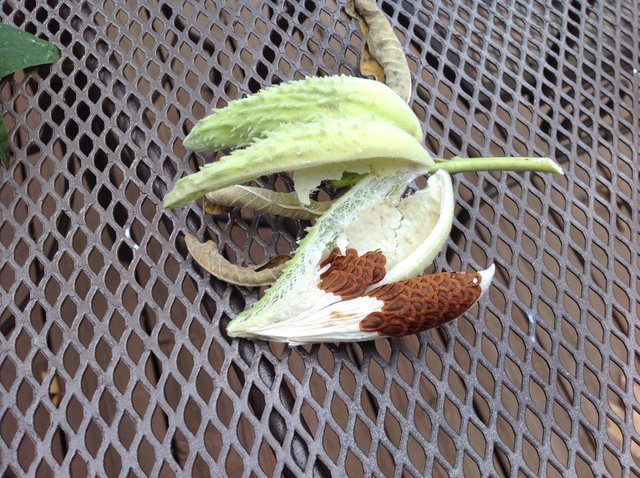
References
Asclepias syriaca - Wikipedia
How to Germinate and Grow Milkweed Seeds
Noxious weed
Images
All photos from the iPad of @kansuze.

@kansuze
I found this extremely interesting thank you for sharing with us. When I started becomeming real old I realised when writing on steemit , it does make it wonderful as you learn something new everyday. With age come knowledge but you never know everything that is for sure.
Very interesting plant!
I see him for the first time.
Interestingly, isn’t thrush growing in the wild so that the butterflies can sit on them in the wild.
They are the only food of the Monarch butterfly caterpillars so, yes, they sit on it.
The Asclepiads or milkweed family all have a white latex sap with is more of a skin or mouth irritant in humans than outright toxic but some are worse than others and they are not livestock friendly. My weird stapeliad flowers that I have been posting are in the same family.
That's interesting. Yes, I think they are named milkweed after the white sap. I read that they have tried to make latex out of it.
Very interesting! We have milkweed here. I have never given any thought to whether or not it is poisonous. I know that the butterflies are attracted to it so I love to see it by the side of the trail where I walk.
There seemed to be doubt as to how poisonous it is. I don't know who studies things like that.
I'm guessing there are university studies on it.
I have already voted for you.
Can I invite you to pay attention to my new project? Resteem and upvote my first post can participate in a 100 STEEM lottery.
Steem Express online | Resteem and upvote can participate in a 100 STEEM lottery
I think this post would be loved by the #naturalnedicine community...
I’m jut going to draw attention to this post to @naturalmedicine....
Perhaps you’d like to come share your knowledge and experience in our Discord? https://discord.gg/UCCEEr
Hopefully see you there 😊🙏🏽🌿
Posted using Partiko iOS
Congratulations @kansuze! You have completed the following achievement on the Steem blockchain and have been rewarded with new badge(s) :
Click on the badge to view your Board of Honor.
If you no longer want to receive notifications, reply to this comment with the word
STOPDo not miss the last post from @steemitboard:
Interesting plant! We do not have this plant here.
Posted using Partiko iOS
For some of us, these things are very interesting.